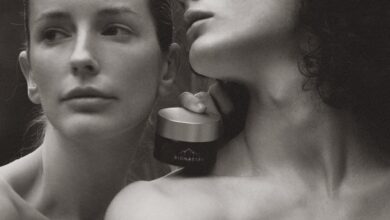We all know the situation. You’ve finished putting on your make-up and it’s all looking good in the mirror, but when you check yourself in the daylight you suddenly realise that you’ve wildly overdone it with the blusher, or missed a bit of foundation. What happened? If you dread applying make-up at home in the bathroom, take heart. The problem may not be your lack of make-up skills – it could be your bathroom lighting.
When you’re doing detailed close-up work such as applying a full face of make-up, proper lighting is absolutely key. But it’s not just a case of improving visibility, though that certainly helps. You need lighting that accurately targets and reflects what you’re doing, so that you don’t regret your decisions regarding colour choices or product quantities used when you step outside into the daylight.
With that in mind, we’ve put together some useful do’s and don’ts for choosing the best lighting conditions for applying make-up.
DON’T Fluorescent strip lighting never did anyone any favours. Cold, white fluorescent light is unforgiving and harshly bright. It’s an unflattering look that will want to make you slap on more foundation, blusher and bronzer than you normally would in order to get rid of your deathly pale complexion and get some colour in your face. But step outside, and you’ll soon realise your mistake.
DON’T Many bathroom lights emit a yellow tinge but the effect of yellow lighting on the skin is that of a sallow, sickly appearance. This may tempt you to go overboard with powder and concealer in an effort to neutralise the colour of your face and hide dark spots. Again, the error of your ways will become very obvious once you look at yourself in normal lighting conditions.
DON’T Rosy light, on the other hand, has the potential of making your complexion look healthy and vibrant. This sounds great but is unfortunately an illusion too. Putting on make-up under pink tinged lighting will make you go too easy on concealer, only to find that you’ve missed a spot or blemish when it’s too late.
DON’T Downlighters may be all the rage when it comes to trendy bathroom lighting design, but they’re not great for make-up application. The light shines down from overhead on wrinkles and pigmentation, casting shadows under eyes for an instantly ageing look. What’s more, the shadows created in wrinkles, eye sockets and under your chin make it nigh on impossible to put make-up on properly.
DO A great solution to help improve your bathroom lighting is to install more lights! In addition to downlighters or other types of ambient lighting, think about fitting softer, diffused lighting at face level. Position a light fitting – perhaps wall mounted light sconces – at either side of your bathroom mirror above the vanity unit, or choose a bathroom mirror with integrated LED lights – a good choice can be found here.

DO When planning the lighting scheme in your bathroom, look to achieve cross illumination or side lighting which will help to create a light that evenly diffuses across your whole face. The most illuminated section of the mirror should be at eye level. If the only lights are at the top of the mirror, your forehead will be illuminated, making you tilt and contort your head and shoulders to get decent lighting onto the rest of your face.
DO Many people choose high wattage light bulbs in the mistaken belief that brighter lightbulbs will improve visibility in the bathroom. However, for the purposes of applying make-up, what you should be aiming for is the optimum quantity of light – which is not the same thing. Opting for lower wattage light bulbs, strategically placed, will create much more suitable lighting conditions.
DO Ultimately, a warm or natural light source will create the best lighting conditions for applying make-up in your bathroom. While natural sunlight – or some would argue overcast light – will provide the most accurate reflection of your skin, a warm white LED light is the next best thing since it closely resembles the colour spectrum of natural light.





